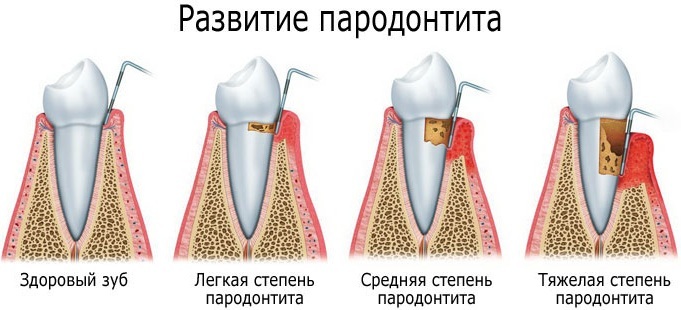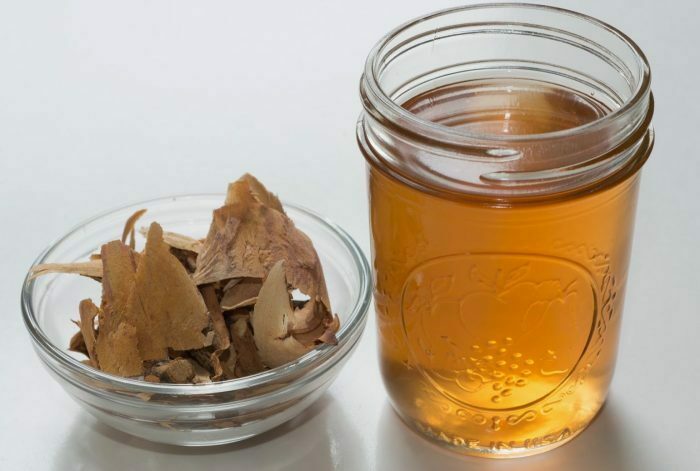Bottle caries in children quite often occurs and gradually eats away at their front upper and lower teeth, which have to be removed or subjected to painful treatment. Caries of this type affects the tooth at the base and very quickly captures the entire surface, leading to disastrous consequences.
The main reason for this is considered to be bottle feeding at night, which is why it is called “bottle feeding”. Only timely diagnosis and proper treatment can preserve the baby's milk teeth.
Record content:
-
1 Stages
- 1.1 Easy
- 1.2 Initial type
- 1.3 Average
- 1.4 Sharp
- 2 Signs
- 3 Causes
-
4 Diagnostic methods
- 4.1 Evaluation of complaints and examination of medical history
- 4.2 Visual inspection
- 4.3 Vital staining
- 4.4 Ultraviolet study
- 4.5 Laser diagnostics
- 4.6 X-ray
-
5 How to treat
- 5.1 Remineralizing therapy
- 5.2 Impregnation method
- 5.3 Enamel infiltration with Icon
- 5.4 Caries preparation
- 5.5 Installation of crowns
- 6 Possible consequences and complications
- 7 Bottle caries video
Stages
Depending on the degree of damage and its nature, bottle caries is divided into several types:
Easy
Bottle caries in children, the treatment of which should be started as early as possible, removes minerals and calcium from the enamel of milk teeth at the initial stage of development. On the visible side of the child's teeth, white-gray or less often brownish blurred spots appear.
This happens at the age of 1-2 liters, immediately after the appearance of all milk teeth. In children, the anterior incisors are affected above and below. At this stage, the child does not have pain or hypersensitivity to sweets or cold foods, so only an experienced specialist can diagnose the disease.
Initial type
If left untreated, bottle caries begins to progress and affect the canines and upper lateral teeth. Gradually, the child's enamel collapses and a small caries (yellow or brown spots) can be seen on the surface of the teeth. Systematically, during or after a meal, the child may complain of discomfort or pain in the teeth.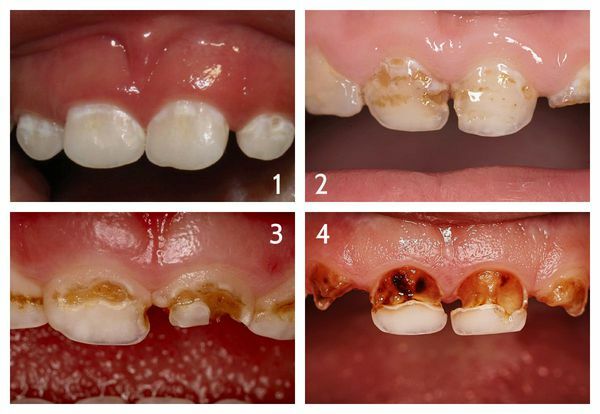
The initial type of bottle caries develops in the period of 20-28 months. With such a lesion of the teeth, a child experiences minor discomfort from cold and hot food. With a low level of vitamins and minerals in the blood, the disease progresses sharply to the next stage.
Average
In the absence of treatment at the age of 2-3 years. caries in children on the surface of milk teeth increases and affects enamel and dentin (bone tissue). The foci of caries multiply rapidly and deepen on the teeth, especially in the gingival region. The color of the caries spots becomes dark brown and black.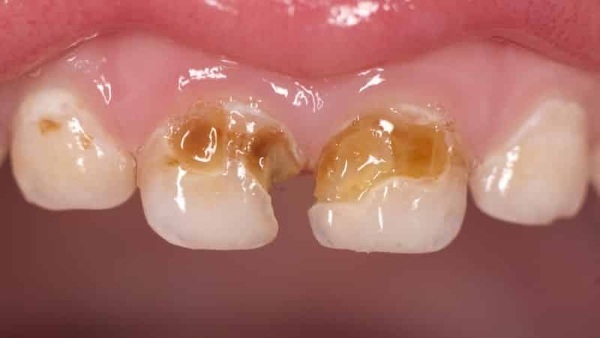
The child constantly complains of pain in the teeth. The baby has discomfort from sweet, salty and sour foods, so the child may refuse to eat or eat very little. In rare cases, there is pain in the teeth at night. The kid becomes nervous and moody. During this period, compulsory treatment with a dentist is required in order to prevent the loss of milk teeth.
Sharp
In the last stage, all layers of dentin in the teeth are gradually destroyed. Caries affects the incisors from below and from above completely, staining them in a dark color. Carious manifestations appear on the canines and lateral teeth. The tissues of the damaged tooth become loose and quickly wear off or fall off.
A deep "hollow" appears in damaged teeth, into which food can be hammered. All this happens in children under 4 years of age. During this period, the child has a constant toothache, hypersensitivity to cold or hot food, sweet and salty. The child eats almost nothing, does not sleep well and is constantly capricious.
| Stage of development of bottle caries | Age period of formation, years |
| easy | 1-2 |
| initial | 2-2,5 |
| average | 2-3 |
| acute | up to 4 |
Signs
Bottle caries in children, the treatment of which should be carried out under the supervision of a specialist, can be difficult to notice in the early stages of onset.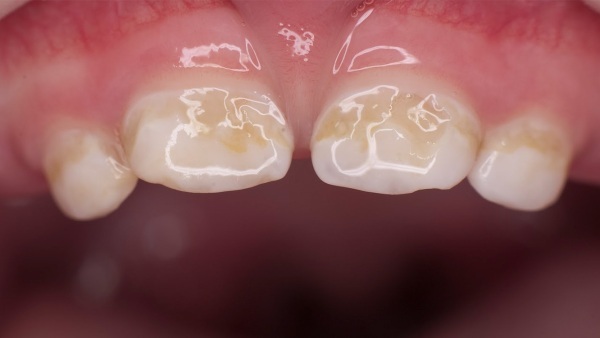
However, it is at this time that the effectiveness of the measures taken by the dentist is considered the highest. The attention of parents to the complaints of the child helps to determine the disease in many respects, on the basis of which it is possible to diagnose bottle caries at the first signs of appearance.
The first signs of bottle caries include:
- darkening;
Slight darkening appears on the upper and lower incisors, often at the base of the teeth, since it is in the amount of calcium and minerals in the cervical region is increased and this area is in contact with liquid food from bottles.
The spots are yellow, grayish or brownish. Soapy in consistency. Spots can be seen not only on the front, but also on the inside of the teeth, since they cover them from all sides.
- soreness;
The child develops minor painful manifestations while eating certain types of food or as a result of food getting stuck between the teeth. The pain may go away after brushing your teeth.
- hypersensitivity.
The child has an increased sensitivity to cold and hot foods. Because of this, the child may refuse food and eat less.
Since the symptoms of bottle caries appear insignificantly in the early stages, parents should pay attention to the condition of the child's teeth and even minor complaints. If the child's complaints recur more than 2 times, the parents should immediately contact the dentist for advice.
Causes
Bottle caries in children, the treatment of which is carried out in a comprehensive manner, occurs, like any other caries, due to damage and destruction of tooth tissues under the influence of acid. A small amount of acid is always present in the mouth. But in large doses, it is produced by microorganisms that actively multiply in the child's oral cavity after eating.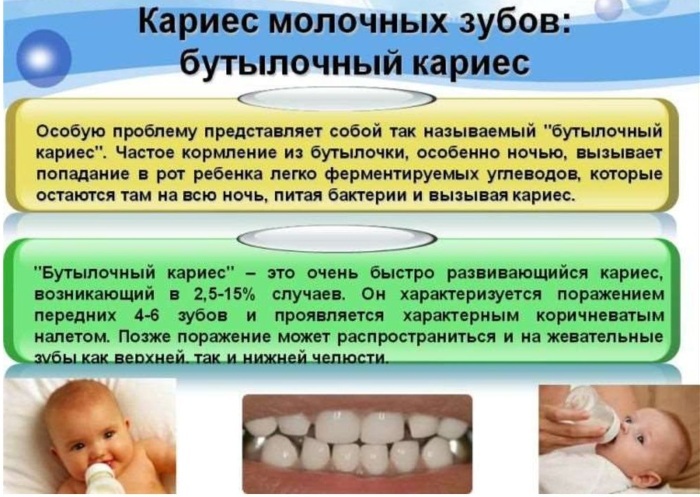
Food for such microorganisms is carbohydrates and sugars, which are contained in a baby's food in large quantities. And the liquid form of food allows food pieces to settle in the most inaccessible places, for example, at the base of the tooth.
Doctors believe that the main reason for the rapid development of bottle caries is the frequent (2 or more times) feeding of the child at night from a bottle or breast. It does not matter the type of feeding, in the case of artificial and natural feeding, a lot of carbohydrates enter the child's teeth. Feeding a baby at night creates a pathogenic environment for the development of bacteria and their active reproduction.
In addition, the development of caries in the front teeth in a child is facilitated by:
- reduced level of immunity;
- avitaminosis;
- insufficient bactericidal properties of saliva (with diabetes, flu, intestinal infection);
- improper diet of the child (inclusion in the diet of a large amount of sweets, juices, flour products and insufficient presence of coarse fiber);
- there is no systematic oral hygiene (not daily brushing, not using toothpaste to clean your teeth);
- the influence of the area (use of water with a low amount of fluoride, air pollution);
- hereditary predisposition;
- bad habits of the baby (grinding teeth in a dream, biting hard objects).
Diagnostic methods
Bottle caries in children is diagnosed only by a dentist, who prescribes further treatment. The following are used as diagnostic methods:
Evaluation of complaints and examination of medical history
Frequent visits to the dentist and parental complaints about increased sensitivity and soreness of the child's teeth are the main symptom of the manifestation of the disease.
Visual inspection
After receiving general information, the doctor must conduct an external examination of the baby's oral cavity. The dentist evaluates the condition of the anterior incisors, canines and lateral upper and lower teeth, even in hard-to-reach places.
Notes the presence of darkening and stains, as well as carious lesions on the surface of individual teeth. Especially carefully the doctor examines the cervical (gum area) of the teeth.
In rare cases, it is difficult to visually determine the onset of carious changes in the teeth. The rudiments of caries can be under the gum, so doctors may resort to additional diagnostic measures, which include:
Vital staining
A 2% solution of methylene blue is applied to the surface of the child's teeth, which does not harm the baby's health, but stains the damaged areas of the enamel in blue of various shades. The more the tooth is damaged, the darker the color will become on the part of its surface. The healthy part of the tooth does not change its color.
Such a study is carried out in a polyclinic or a private dental office and is considered the simplest and most effective in determining the presence of bottle caries and making a diagnosis. The cost of this procedure is 350 rubles.
Ultraviolet study
Carrying out stomatoscopy with ultraviolet irradiation allows you to quickly identify damaged areas of the teeth. Healthy teeth in ultraviolet light glow light green, and carious lesions, on the contrary, do not luminesce.
Such a simple and quick method makes it easy to establish the presence of damage to the enamel on the teeth on the sides and gum area. The study is painless and takes no more than 7 minutes. Research is carried out in clinics and private dental centers, its cost ranges from 400 rubles.
Laser diagnostics
In rare cases, the child is assigned a laser diagnosis with the KaVo Diagnodent. This machine emits a laser beam with a wavelength of 655 nm. A laser beam hitting the tooth tissue allows you to assess their density to the deepest layers.
Areas of carious lesions on the teeth during laser exposure reflect a wave with other indicators, therefore, within a few minutes, the doctor can get a detailed picture of the health of the oral cavity child. This procedure is carried out only in private dentistry, its cost ranges from 1100 rubles.
X-ray
The simplest and most popular is the X-ray method, which is used only if there is suspicion of carious changes. The child is assigned an x-ray of the upper and lower jaw of the mouth.
One snapshot allows you to assess the presence of caries in hidden places, the degree of tooth damage and the nature of the spread of the disease. X-rays are done in dental clinics and dental centers on special devices. The cost of the procedure is from 700 rubles.
Bottle caries in children is often similar in symptoms to other diseases (systemic hypoplasia and fluorosis). Non-carious damage to teeth has other methods of treatment, therefore, competent diagnosis is the basis for further correct treatment.
How to treat
Bottle caries in children, the treatment of which begins only after diagnosis, requires, first of all, a change in the child's diet and diet. Sweet, sour, salty foods are excluded from the baby's diet. A diet rich in calcium and fiber is recommended, and frequent night snacks are avoided.
In addition, the child is prescribed complex treatment, which is divided into:
- operating room (invasive);
- non-invasive.
Non-surgical treatment is carried out at an easy stage of the course of the disease and in the presence of minor damage to the enamel in the child. As non-invasive measures, the following are used:
Remineralizing therapy
The main reason for the development of bottle caries is the leaching of minerals and calcium from the baby's milk teeth. To restore the mineral composition of the teeth in children, they are covered with a special liquid that fluorinates their surface. The enamel of the teeth is sealed, and calcium chloride is formed on the surface of the teeth, which penetrates into the tooth and restores the mineral composition.
Impregnation method
At the initial and middle stage of development of bottle caries, treatment with the impregnation method is allowed. Silvering is carried out with an alcohol solution of silver nitrate, as a result of which the root canals of the teeth are sealed.
After such treatment, a thin protective film appears on the surface of the teeth, which protects the enamel and dentin from further destruction. However, after this treatment, the child's teeth turn black.
Operational methods are used in extreme cases, since the child rarely gives in to deep dental treatment and it is difficult to tolerate anesthesia. With medium and deep damage to the teeth under local or more often general anesthesia, surgical treatment of damaged teeth in the oral cavity is carried out by the following methods:
Enamel infiltration with Icon
The surface of the tooth is treated with a 15% hydrochloric acid solution, which closes the enamel pores. Deeper cavities are cleaned and filled with a mixture of synthetic resins, which quickly block all microchannels and do not wash out. Such a simple method can be carried out with minor damage to the tooth, it is considered gentle.
Caries preparation
In case of moderate or deep damage to the milk tooth, the dentist may recommend opening the caries. Under general or local anesthesia, the child is cleaned of the damaged area from caries using a drill.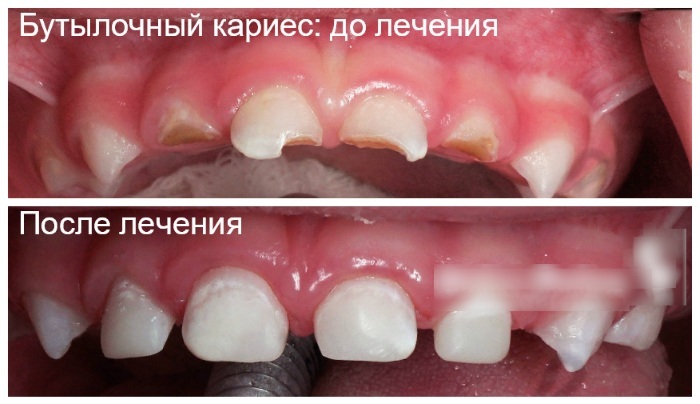
The cavities are cleaned and drained and then filled with glass ionomer cements. Such a filling restores the tooth and protects it from further decay.
Installation of crowns
With extensive destruction of the main part of the tooth, it is closed with an iron crown. This not only protects the tooth from further decay, but also allows it to be preserved for a long time.
Crowns are most often installed on the lateral upper and lower teeth, which are more involved in the chewing process. Less commonly, crowns can be placed on the upper incisors. Crowns can be iron or covered with white enamel to match the teeth.
Possible consequences and complications
Bottle caries occurs suddenly and quickly develops in the mouth. If untreated, caries on a child's teeth is increasingly spreading and deepens, in connection with which serious complications may appear in the form of:
- vitamin deficiency and a decrease in the child's immunity due to complete or partial refusal of food;
- pulpitis or inflammation of the inner soft part of the tooth;
- periodontitis (inflammation of the soft tissue around the tooth);
- the formation of an irregular bite due to soreness when bitten;
- loss of most of the milk teeth at an early age;
- lesions of permanent teeth, which erupt already with damaged enamel.
Bottle caries in children is a common and common disease that occurs on average in 30% of children and requires urgent treatment.
Milk teeth contribute to the full development of the jaw, nervous system and the general development of the child, therefore, at the first complaints of pain and discomfort in the teeth, parents should consult a doctor in order to avoid deplorable complications and operations.
Attentive attitude of parents to the complaints of the baby, timely diagnosis at the dentist and competent treatment can eliminate the initial symptoms of the disease and keep everything in the child baby teeth.
Bottle caries video
What is bottle caries:

